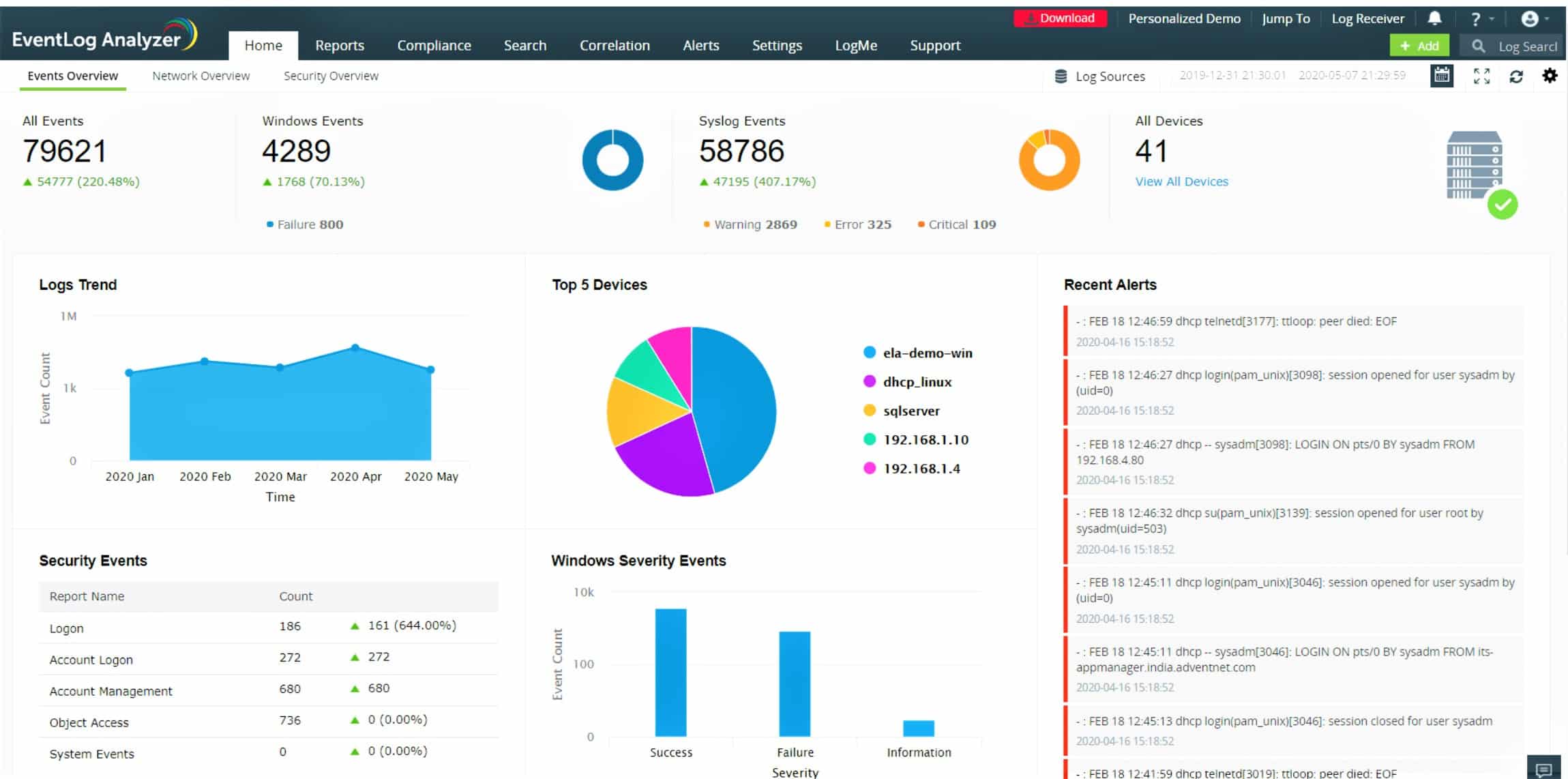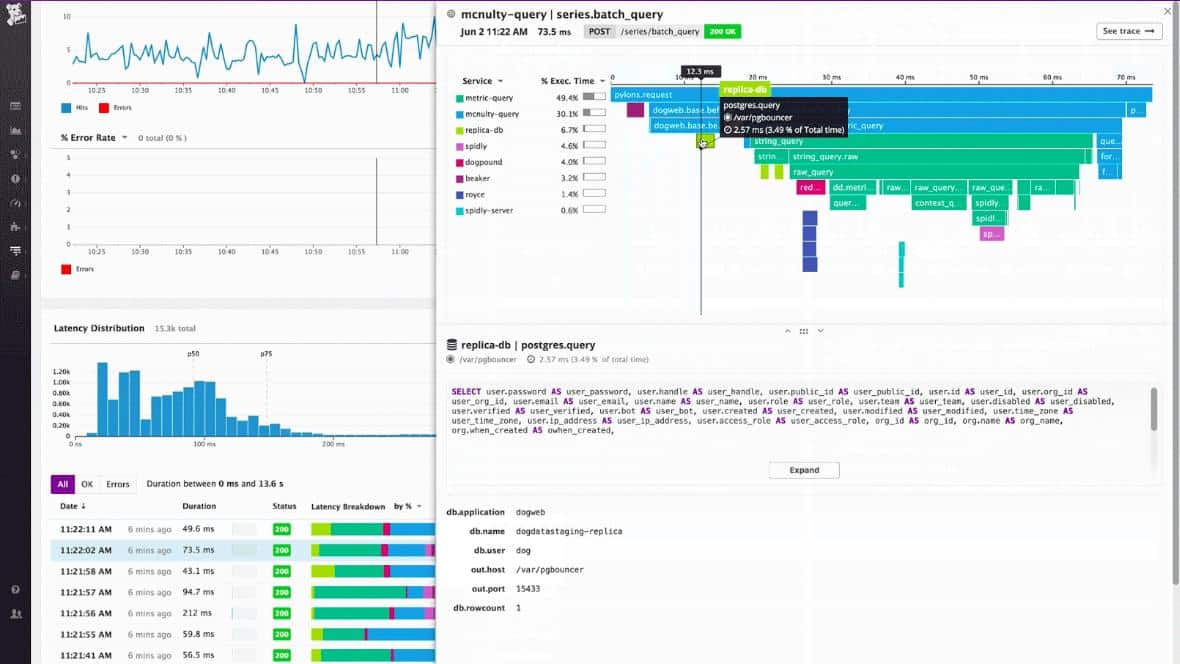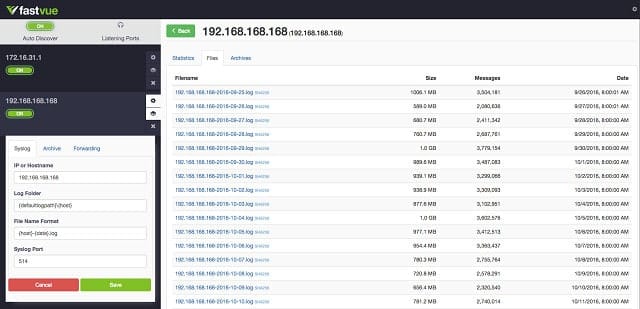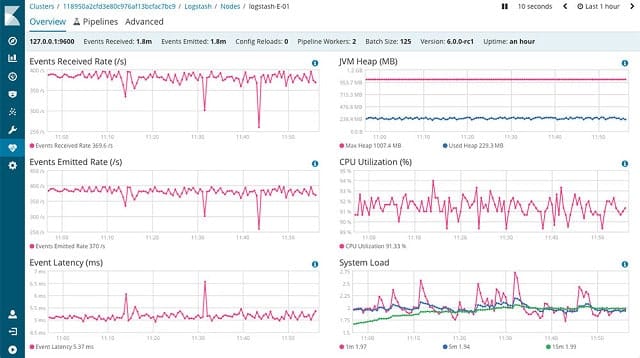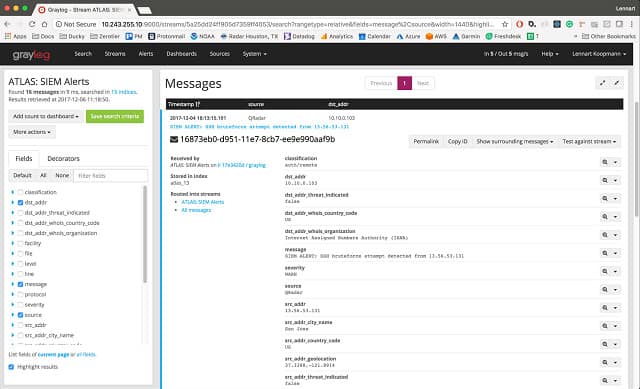The Syslog message format is one of the oldest standards in IT, dating back to the 1980s. It was originally implemented in a Unix-based program called Syslog-ng. The format used by that package was adopted by other software to ensure compatibility. Eventually, the layout of Syslog messages and the codes that go into some of its fields were specified in an RFC by the Internet Engineering Taskforce (IETF).
Here is our list of the best Syslog and Log viewers:
- Paessler PRTG EDITOR’S CHOICE This large package of monitoring tools includes a Syslog receiver that will show messages as they arrive. It is also able to act as a log manager for other formats, such as Windows Events. Available for Windows Server or as a SaaS platform. Get a 30-day free trial.
- ManageEngine OpManager (FREE TRIAL) A robust syslog monitoring tool with comprehensive features, simplified syslog capabilities, and customizable alerts for detailed network and system monitoring. Download a 30-day free trial.
- Site24x7 Log Management (FREE TRIAL) This cloud-based system includes a data viewer for received log messages, including those in the Syslog format. Start a 30-day free trial.
- ManageEngine EventLog Analyzer (FREE TRIAL) This package provides both a log server and a local collector. The system can standardize all logs into a common format. Available for Windows Server or as a SaaS platform. Start a 30-day free trial.
- Datadog Log Management A cloud-based log manager consolidates Syslog messages with other log types, such as Windows Events. In addition, the Log Explorer includes data analysis features that can be used for a range of applications, including security monitoring.
- Loggly A cloud-based system that receives and consolidates log messages from different formats, shows arriving log messages and offers a viewer for data analysis.
- Kiwi Syslog Server A Syslog log manager with live message views, data analysis functions, and file management. This package installs on Windows and Windows Server.
- Fastvue Syslog A free Syslog server includes a live tail message display and a file viewer for older records. It runs on Windows.
- ELK Stack A free suite of tools for log collection, analysis, and display that can collect Syslog messages and consolidate them with other log message formats. It runs on Linux.
- Graylog A log management system that is free for low throughput volume and includes merging Syslog records with Windows Events. It runs on a VM.
By complying with the Syslog message format, software producers can be sure that their customers will find utilities created by others to gather, sort, view, and store those messages.
Running a Syslog server
To benefit from the information imparted by Syslog messages, you need a collector and a client to gather and upload them to a Syslog server.
Syslog messages can be pertinent to security events and so processing these messages quickly and making them available at a central Syslog server immediately is very important. Additionally, SIEM systems rely on log messages for their source data, and the sooner you can get those messages to your SIEM software for threat hunting, the sooner a threat can be identified and blocked.
The log server has several tasks to perform, which one software package might be able to implement all of them. Some programs serve just one of those duties.
The work that a Syslog server will perform includes:
- Receiving Syslog messages
- Displaying arriving messages in a console – called ‘live tail’
- Converting messages into a neutral format along with messages created through other standards – this is called “consolidation”
- Creating a log directory structure
- Creating a log file and writing messages into it as they arrive
- Closing the log file and starting another – this is called logfile rotation
- Reading log files into a viewer for analysis
These are the basic tasks of a log manager. A log server that is part of a security monitoring service will include pre-written searches that scan through new records taking in a set of messages on a continuously moving frame, such as the last five minutes. Some log management systems write log messages in a database instead of storing files.
Related post: The Best Free Syslog Server List
The best Syslog and log viewers
When finding a good viewer for Syslog messages, it is good to find a system that can handle all formats of log messages. Viewers tend to just load in records, and the ability to show log messages that are written to different standards in the same screen relies on the skills of a log consolidator, which will need to pre-process all messages before the viewer accesses them.
What should you look for in a Syslog and log viewer?
We reviewed the market for Syslog and log viewing packages and analyzed tools based on the following criteria:
- Integrated consolidator or an associated utility
- Options to sort, filter, and group records
- Highlight related Syslog messages
- Link together records for further investigation
- Option to reformat and export records
- Free tool or a system with a free trial
- Value for money from a reliable and fast tool that can quickly read and sort through Syslog records.
We have identified both free and paid tools that provide excellent Syslog viewing services with these selection criteria in mind.
The Best Syslog and Log Viewers
1. Paessler PRTG (FREE TRIAL)
Paessler PRTG is a large package of monitoring tools that include a Syslog server and log viewer. The log receiver is designed to streamline log management and network diagnostics. It centralizes log data collection, providing an intuitive interface to view and analyze Syslog messages alongside other log formats. PRTG’s log viewer offers real-time insights, advanced filtering, and visualization tools, making it easier to identify issues and maintain network health.
Key Features:
- Centralized Log Collection: Aggregates Syslog messages from multiple devices into a unified interface, simplifying log analysis.
- Real-Time Monitoring: The system provides live insights into Syslog data, enabling immediate detection of unusual activity or critical events.
- Customizable Alerts: Users can configure triggers for specific log entries, ensuring instant notification for predefined events or anomalies.
- Detailed Log Filtering: Advanced filtering options allow users to pinpoint relevant Syslog messages quickly.
- Visual Dashboards: PRTG displays Syslog data with graphs, lists, and tables.
The PRTG package extends its capabilities beyond Syslog to support other log types such as Windows Event Logs and SNMP Traps. The platform enables centralized logging across diverse network devices and environments. With PRTG, administrators can manage logs from Linux servers, Windows machines, and network appliances in one place, enhancing visibility and simplifying troubleshooting for mixed-OS environments.
Pros:
- Ease of Use: Interface is user-friendly, with straightforward configuration and operation.
- Scalability: Scale from small setups to large enterprise environments, adapting as network demands grow.
- Extensive Device Support: Works with a wide array of hardware, from routers and switches to servers and IoT devices.
- Granular Permissions: Role-based access control ensures secure log management by limiting data visibility to authorized users.
- Automation Options: Inclusion of APIs allows for integration with other tools and automated workflows.
Cons:
- Resource Intensive: Can require significant system resources, especially in larger deployments, necessitating careful planning.
Paessler PRTG is more than just a Syslog server. It provides comprehensive network monitoring capabilities, including bandwidth tracking, application monitoring, and uptime checks, all accessible via a single console. Buyers have the option of downloading the PRTG software to run it on Windows Server or sign up for the cloud-based SaaS version. The package is free forever for up to 100 sensors. Paessler offers a 30-day free trial of PRTG with all sensors activated.
EDITOR'S CHOICE
Paessler PRTG is our top pick for a Syslog and log viewer because of its reliability, user-friendly interface, and comprehensive monitoring capabilities. This service can collect, analyze, and visualize Syslog messages from diverse devices, providing IT administrators with the tools needed to maintain optimal network performance. PRTG consolidates log data into a single, intuitive platform, making it easier to diagnose issues, detect anomalies, and streamline troubleshooting processes. The wider PRTG package provides real-time monitoring for IT assets and the log monitoring unit of the platform offers an extra layer of information about what challenges the equipment is facing. This is complemented by advanced filtering options, enabling users to pinpoint specific log entries quickly. With its customizable alerts, IT teams can set triggers to notify them of critical events, ensuring a proactive approach to problem resolution. The visual dashboards in PRTG provide clear, graphical representations of log data, aiding in quick comprehension of complex information. Beyond Syslog, PRTG supports other log formats, including Windows Event Logs and SNMP Traps. This multi-format capability allows it to support Linux servers, Windows workstations, or network appliances.
Download: Start a 30-day FREE Trial
Official Site: https://www.paessler.com/download/prtg-download?download=1
OS: Windows Server
2. ManageEngine OpManager (FREE TRIAL)
ManageEngine OpManager is a top syslog monitoring tool due to its comprehensive and customizable syslog management features. It allows for the creation of detailed syslog rules, forwarding syslog messages, and monitoring specific ports for syslog transmission.
Key Features:
- Syslog Rules: Create customized rules to manage syslog messages based on severity, occurrences, and time intervals.
- Port Monitoring: Monitor specific ports for syslog transmission and assess flow rates to ensure prompt delivery.
- Syslog Forwarding: Forward received syslog messages to specified destination devices with ease.
- Unified Syslog Viewer: View all syslogs in a unified interface, showing source, facility, severity, and response time.
- Message Filtering: Filter syslogs by facility name, severity, and keyword/regex match for precise monitoring.
- Severity Assignment: Assign severity levels to incoming syslogs and create corresponding alarms.
- Flow Rate Monitoring: Instantly know the syslog flow rate into OpManager to monitor network activity.
- Customizable Reporting: Generate reports based on host, data, severity, group, and event type for detailed analysis.
- Noise Reduction: Intelligently correlate incoming syslogs to reduce unnecessary log noise and save space.
The unified syslog viewer presents all necessary information in one interface, making it easier for administrators to track and respond to critical events. The platform’s intelligent noise reduction feature filters out irrelevant logs, enhancing efficiency and saving valuable time.
Pros:
- Comprehensive Syslog Management: Offers detailed syslog monitoring, including rule creation, forwarding, and filtering.
- Unified Viewer Interface: Provides a single view for all syslogs, enhancing monitoring efficiency.
- Customizable Alerts: Allows customization of alerts based on severity, reducing the chance of missing critical events.
- Efficient Noise Reduction: Rule-based reading of syslogs reduces log noise, saving administrators time.
- Flexible Reporting: Customizable reports provide in-depth insights into system and network performance.
Cons:
- Complex Configuration: Initial setup and rule configuration can be complex for new users.
Gain access to the 30-day free trial.
3. Site24x7 Log Management (FREE TRIAL)
Site24x7 Log Management is a cloud-based service that collects log messages and makes them available for analysis in a data viewer. The log viewer includes analytical tools to search, sort, and filter messages, which is a useful utility for ad-hoc investigations.
Key Features:
- Log Message Consolidation: Aggregates log messages from various sources into a unified format for analysis.
- Throughput Statistics Generation: Offers insights into log message volume and processing efficiency.
- Advanced Analytical Tools: Includes features for in-depth search, sort, and filter capabilities within the log viewer.
Why do we recommend it?
Site24x7 Log Management provides a comprehensive cloud-based solution for log collection and analysis, featuring robust analytical tools that cater to ad-hoc investigations and routine monitoring needs.
The Log Management unit collects Syslog messages from Linux operating systems and also from applications. The tool is not limited to managing Syslog messages; it can also collect Windows Events and logs from different software packages.
The Site24x7 platform is a SaaS system with a range of plans, which includes an edition for managed service providers. The Log Management service is bundled into each plan and provides an extra method for investigating problems or setting up additional performance and security monitoring searches.
Who is it recommended for?
Ideal for businesses of all sizes, especially those seeking a scalable solution that can handle logs from Linux, Windows, and various applications without the need for on-premise infrastructure.
Pros:
- Versatile Log Collection: Efficiently collects and standardizes log messages across different formats and platforms.
- Real-Time Data Viewer: Displays incoming messages dynamically, allowing for immediate analysis.
- Log Storage: Archives log messages for future reference and analysis, enhancing data retention capabilities.
Cons:
- Package Integration: Available only as part of a broader Site24x7 service package, limiting standalone utility.
The Site24x7 platform provides plans that are sized and priced to be suitable for small businesses. Larger companies pay for capacity expansions, so the system can scale up to work for any size of organization. You can investigate the Site24x7 platform further by accessing a 30-day free trial.
4. ManageEngine EventLog Analyzer (FREE TRIAL)
ManageEngine EventLog Analyzer is a log manager that also provides both manual and automated threat hunting. The system collects log messages from all around the network and then consolidates them into a common format. So, it will gather Syslog and Windows Events messages, plus other log message formats used by some software packages.
Key Features:
- Comprehensive Log Collection: Gathers and standardizes log messages from diverse sources across the network.
- Log Parsing and Forwarding: Offers flexibility in handling log messages, allowing for forwarding in both original and converted formats.
- Advanced Data Viewer: Equipped with analytical tools to sort, filter, and group log messages for in-depth analysis.
Why do we recommend it?
ManageEngine EventLog Analyzer excels at consolidating log data from numerous sources into a coherent format, augmented by its manual and automated threat hunting capabilities, making it a robust tool for security and compliance.
While all of the messages arriving at the log server get converted to a common format, it is also possible to forward the original messages without alteration or after conversion. These messages all get filed, but you can selectively filter messages to weed out low priority notifications and debugging messages.
After conversion, all of the messages processed by the log server get displayed in a data viewer that is part of the EventLog Analyzer dashboard. The data viewer includes analytical tools, such as sort, filter, and group. The system lets you examine just Syslog messages if that’s what you want. You can create your own threat detection queries and set them to run continuously. There is also a library of pre-written queries that constitutes a SIEM service.
Who is it recommended for?
Suited for organizations of any size, from small businesses to large enterprises, looking for a detailed log management system with the added benefit of SIEM capabilities for enhanced security posture.
Pros:
- Versatile Log Management: Collects, files, and analyzes log messages from various sources, facilitating comprehensive network oversight.
- Flexible Message Forwarding: Enables strategic log forwarding to third-party tools, enriching security and operational workflows.
- Historical Analysis and Compliance Support: Assists in maintaining records for historical analysis and compliance auditing, reinforcing data governance.
Cons:
- SIEM Functionality: While it offers SIEM-like services, it is not primarily marketed as a full SIEM solution, potentially requiring additional tools for complete security management.
The ManageEngine system is available in a number of editions. There is a Free edition, but that is limited to collecting logs from five sources. The lowest paid package can collect from up to 1,000 log sources and the top plan will operate log collection for a large WAN. All editions are available on the cloud platform and with the on-premises version. You can try a single site license with a 30-day free trial.
5. Datadog Log Management
Datadog Log Management is a cloud-based package, which means that it can receive log messages from anywhere, and the console is available through any standard web browser. The Datadog system can receive all types of log messages, and there are guides in the Datadog documentation system that explain how to install a Syslog collector. The service can collect log messages from 170 different systems.
Key Features:
- Real-Time Log Statistics: Displays live statistics on incoming log messages, offering immediate insights.
- Unified Log Consolidation: Aggregates log messages from multiple sources into a standard format for simplified management.
- Log Explorer: Enables in-depth analysis of stored log messages with powerful search and filtering tools.
- Customizable Record Tagging: Allows for the addition of custom tags to log records for enhanced organization and retrieval.
- Advanced Analytical Tools: Features a suite of analytical tools within the data viewer for comprehensive log analysis.
Why do we recommend it?
Datadog Log Management is a robust, cloud-based log management solution that excels in collecting, consolidating, and analyzing log messages from a wide range of sources, making it invaluable for comprehensive log oversight and analysis.
The Log Manager receives Syslog and other log messages, consolidates them into a standard format, and stores them. Each message is shown live in the console as it arrives. The consolidator will reference the source of each message, and you can also specify your custom tags.
Datadog Log Manager stores log messages to file. You can specify your storage location or rent space on the Datadog server. The Log Manager can also compress files for archiving, and you can get them revived on demand. Stored files can be read into the Log Explorer for analysis.
Datadog Log Management can perform and ’consolidate log messages from many different systems and file them and give you a way to view records. The console presents ongoing statistics about log message activities and shows live tail messages as they arrive. First, read messages into the Log Explorer from files to analyze your system’s activity. Then, create your own saved searches and automatically apply them to coming log messages.
The Log Management service can be enhanced by subscribing to the Application Performance Monitoring service. This produces distributed tracing logs for microservices, and feeding those through to the Log Management module lets you see how the performance of those functions is dependent on system resources and other events on the network.
Who is it recommended for?
Ideal for organizations of all sizes looking for a powerful, scalable log management tool that can handle logs from over 170 different systems, offering detailed analysis and real-time monitoring capabilities.
Pros:
- Versatile Log Collection: Efficiently merges log messages in various formats, ensuring broad compatibility and comprehensive coverage.
- Dynamic Log Viewing: Incorporates a real-time data viewer with analytical tools, enhancing the analysis and monitoring of log activities.
- Flexible Storage Solutions: Offers options for log message storage and archiving, with the ability to compress and revive files as needed.
- Real-Time Monitoring: Provides live updates on log message activities, enabling immediate response to system events.
Cons:
- Storage Costs: Additional charges for storage space, which is not included for free, may impact overall cost considerations.
There are two elements to the Datadog Log Management service. The first is the actual processing system, which is charged per GB or processed data. The other service is the storage space, which you don’t have to take from Datadog. The price for this service depends on the length of time that you want to store log files. You can get a 14-day free trial of both services.
6. Loggly
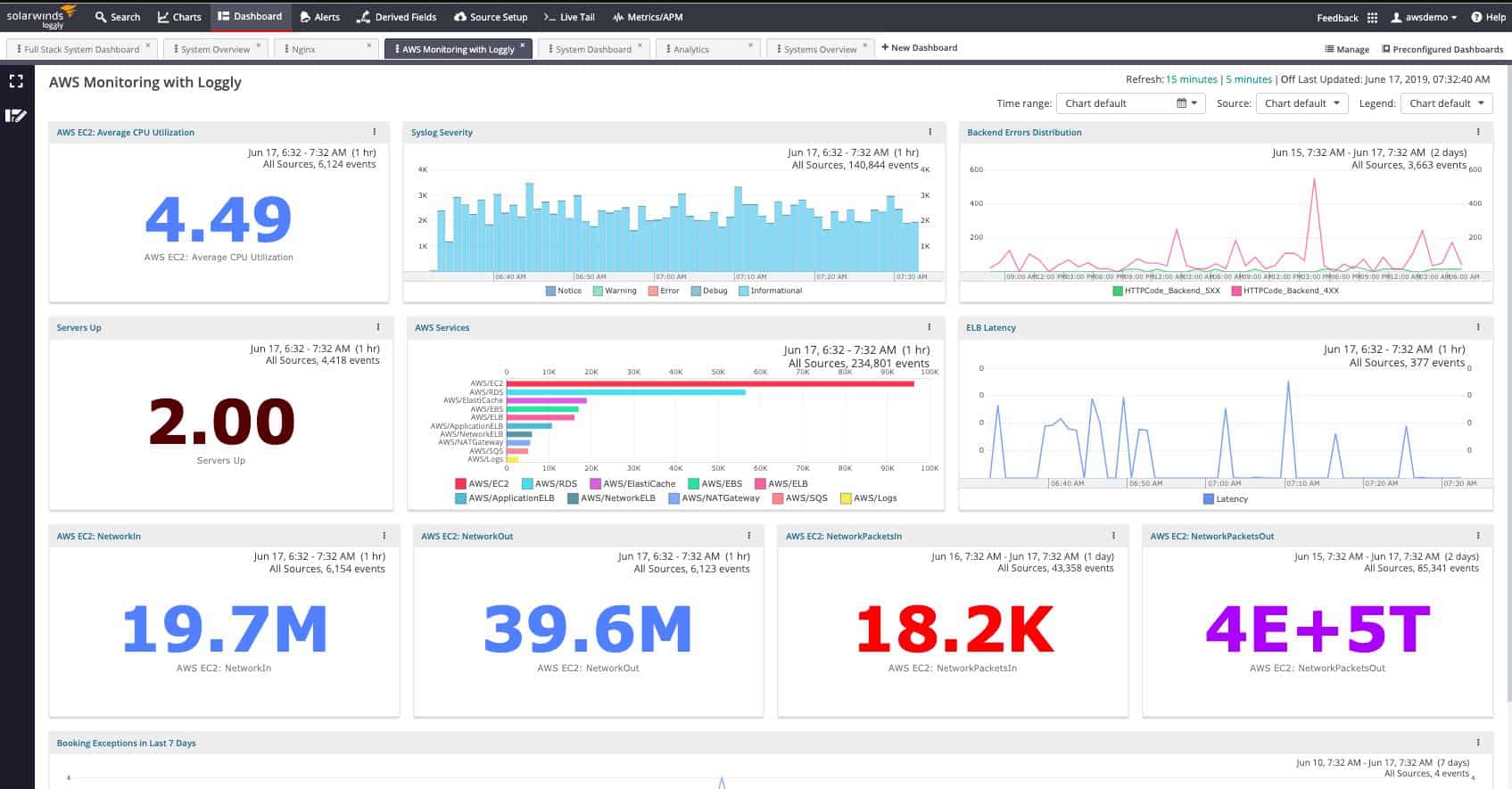
Loggly is a cloud-based log server, consolidator, and analyzer. It can process Syslog messages as well as logs from other sources. Integrations create the compatibility of the server. You activate an add-on for each log format that you want your Loggly implementation to process.
Key Features:
- Syslog Server Integration: Processes Syslog messages and logs from various sources seamlessly.
- Log Consolidation: Combines logs from multiple sources into a unified platform for easier management.
- Analytical Log Viewer: Features a log viewer with analytical tools for in-depth log analysis.
- File Management: Efficiently manages filing and archiving of log files on the cloud.
Why do we recommend it?
Loggly‘s comprehensive cloud-based log management system, equipped with versatile integrations and analytical tools, makes it an invaluable asset for monitoring AWS cloud environments effectively.
Loggly is a competent log file manager. Those files are stored on the Loggly server, and the storage space is included in the package price. The retention period for those files depends on the plan that you choose. While a log file is on the Loggly server, it can be selected and read into the data viewer included in the Loggly console.
Who is it recommended for?
Highly suitable for developers and IT professionals in need of a robust log management solution that offers seamless consolidation, analysis, and storage of logs from both on-premise systems and cloud platforms.
Pros:
- Efficient Data Collection: Simplifies the collection and management of logs across diverse systems and platforms.
- Comprehensive Log Analysis: Provides powerful analytical tools for detailed log examination and insights.
- Wide Integration Capability: Supports integrations with major project management and collaboration tools, enhancing workflow efficiency.
- Scalable Storage Solutions: Offers flexible storage options, with retention periods adjustable according to the chosen plan.
Cons:
- Post-Retention Planning Required: Necessitates a strategy for log management following the end of the retention period.
There are four plans available for Loggly; Lite is free, which can process 200MB of data per day, and the three paid plans have higher data throughput allowances, up to 100GB per data with the Pro edition.
Try Loggly with a fully functional 30-day free trial.
7. Kiwi Syslog Server
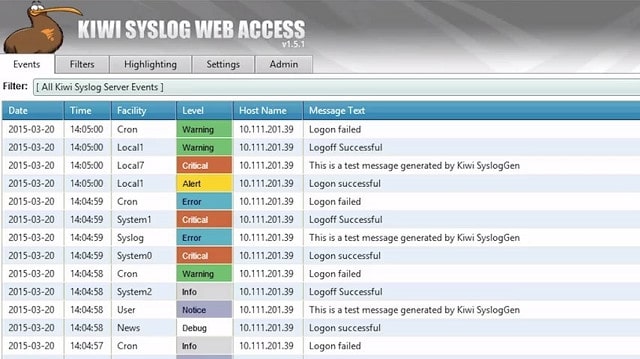
Kiwi Syslog Server is an on-premises solution that enables you to manage your log files in-house. This tool will collect band consolidate Syslog messages and those of Windows Events. The server can also process SNMP Trap messages, emergency warnings sent out by network devices.
You can specify conditions that raise concern and that will trigger an alert. Examples of such conditions are if a device breaks down or if log message delivery frequency increases by a certain percent.
Key Features:
- Syslog and Windows Event Integration: Collects and consolidates Syslog messages and Windows Event logs efficiently.
- Log Consolidation: Merges logs from various sources for streamlined management.
- Interactive Log Viewer: Features a color-coded log viewer with analytical tools for real-time analysis.
Why do we recommend it?
Kiwi Syslog Server excels at in-house log file management, offering robust features for collecting, consolidating, and analyzing Syslog and Windows Event logs with an intuitive, web-based dashboard.
Who is it recommended for?
Ideal for IT professionals and system administrators who prefer an on-premises solution for centralized log management, especially in environments that utilize a mix of Windows, Linux, and Unix systems.
The Kiwi system’s console is web-based, although you host it on your server. The dashboard includes a log message viewer that also provides analytical tools. When used to just display log messages, the viewer color-codes records, which is a treatment that you can customize. Messages are shown live in the dashboard as they arrive, and it is also possible to read log files into the data viewer for analysis.
Pros:
- Comprehensive Log Processing: Effectively processes and stores log messages from multiple platforms, ensuring no data is overlooked.
- Real-Time Visibility: Displays Syslog and Windows Event messages live as they arrive, enhancing monitoring capabilities.
- Advanced Analysis Tools: Allows for in-depth analysis of log files loaded into the viewer, aiding in quick decision making.
Cons:
- Requires On-Premise Server: Necessitates dedicated server hardware to host the solution, adding to the overall investment.
Kiwi Syslog Server runs on Windows or Windows Server, but it can collect Syslog messages from Linux and Unix hosts across the network. It will also collect messages from network devices. You can assess the system with the free edition.
8. Fastvue Syslog
Fastvue Syslog is an excellent choice as it is entirely free to use. The package has an attractive interface, and it will collect Syslog messages from the network. This is a standalone package that can file all of your Syslog messages. It can also forward records to bother Syslog processing and analysis tools.
Key Features:
- Message Collection: Automatically captures syslog messages from various devices across the network.
- Log Filing: Organizes syslog messages into files for easier management and retrieval.
- Record Forwarding: Provides the option to send logs to other syslog analysis and processing tools.
- Integrity Verification: Utilizes SHA-256 hashing to verify log files against tampering.
- Automatic Compression: Archives files can be automatically compressed after a set period to save space.
Why do we recommend it?
Fastvue Syslog stands out for its cost-effectiveness and straightforward approach to syslog management, offering key functionalities like automatic message collection and flexible archiving options without any associated cost.
The package formulates statistics on log message throughput. As well as filing Syslog messages, the Fastvue system generates an SHA-256 hash so that you can check for tampering. In addition, the system can automatically apply compression to archive files after a period that you specify.
Who is it recommended for?
This tool is ideally suited for small to medium-sized businesses or IT professionals seeking a no-cost solution for basic syslog message collection and filing, without the need for advanced analysis features.
Pros:
- Effortless Syslog Management: Automatically gathers and organizes syslog messages, simplifying network management.
- Flexible Archiving: Allows for customizable compression and archiving of log files, enhancing data storage efficiency.
- Convenient Log Viewing: Features a logfile viewer for easy access to specific records.
Cons:
- Limited Analysis Tools: Lacks built-in utilities for log consolidation or detailed analysis.
- Restricted Log Sources: Cannot ingest log records from non-syslog systems like Windows Events.
The log viewer in the Fastvue system only shows records from a specific file – it doesn’t include any analytical tools. This package also can’t ingest log records from other systems, such as Windows Events. However, as it is a free tool, it is worth considering and buys you time searching for something better. This software installs on Windows.
9. ELK Stack
ELK Stack, also known as Elastic Stack, is a free suite of tools that collect and manage logs. This system runs on Linux and will easily manage your Syslog messages. The element that gathers log messages, consolidates them, and files them is Logstash. This is the ‘L’ of ELK.
Key Features:
- Syslog Management: Seamlessly collects and organizes Syslog messages, ensuring efficient log handling.
- Log Consolidation: Integrates and organizes logs from various sources, providing a unified view.
- Advanced Search: Leverages Elasticsearch for powerful data querying and analysis capabilities.
Why do we recommend it?
ELK Stack is recommended for its comprehensive suite of tools that not only simplify log management but also offer advanced data analysis capabilities, making it a valuable asset for any organization looking to leverage their log data.
The ‘E’ of ELK is the Elasticsearch system. This powerful data analysis system is integrated into many other log analysis and security monitoring tools. You can write Elasticsearch queries and then run them automatically to create your data analysis system.
The ‘K’ of ELK is Kibana, a frontend for the whole system. You have to set up the interface yourself because Kibana can display any data source, not just Syslog messages. Once everything is organized, you will have Logstash collecting Syslog messages and creating log files, Elasticsearch creating analysis and data presentation functions, and Kibana displaying all of your Syslog data.
Who is it recommended for?
This solution is ideal for businesses and IT professionals who require a sophisticated log management system capable of detailed data analysis and have the technical skills to implement and maintain the system.
Pros:
- Cost-Efficient: Offers a robust log management solution without any initial investment.
- Cloud Hosting Option: Availability of a hosted version with storage for those preferring cloud solutions.
- Automated Analysis: Facilitates the automation of data analysis, enhancing operational efficiency.
Cons:
- Setup Complexity: Implementation requires a certain level of technical expertise.
There are many plans for the cloud-hosted service of Elastic Stack, with prices starting at $16 per month. An advantage of getting the paid service is getting an edition that includes pre-written screens for log management, so you need fewer technical skills to benefit from the service. In addition, you can get a 14-day free trial to assess the paid system.
10. Graylog
Graylog has been around since 2009. Originally an open-source project, Graylog is now available in a paid version, and the free system is now called Graylog Open. The longevity of this system means that it is well-known, stable, and has a large user community. Unfortunately, if you opt for Graylog Open, you don’t get professional support, but you can join the user forums and find advice.
Key Features:
- Established Reliability: Well-known system with a solid track record for stability and a vast user community.
- Comprehensive Log Handling: Acts as both a log server and consolidator, efficiently managing various log types.
- Versatile Log Management: Offers extensive capabilities for managing, filing, and forwarding logs.
Why do we recommend it?
Graylog is recommended for its proven stability and comprehensive log management capabilities, making it a reliable choice for organizations looking to centralize and simplify their log handling processes.
Graylog can collect Syslog messages, and it can also obtain Windows Events. The service will consolidate the records that arrive from these two different systems and also collect logs from third-party applications. The system will file and forward messages, and so it could just be used as a Syslog server. The dashboard for the system is attractive and flexible. However, it doesn’t come out immediately all set up and ready to run. You have to set it up by creating screens from templates or by selecting widgets and associating them with data sources.
Who is it recommended for?
This platform is suited for medium to large enterprises or IT professionals who need a robust log management system capable of handling a variety of log types and have the technical expertise to set up and customize the system.
Pros:
- Diverse Log Collection: Capable of integrating both Syslog and Windows Events, broadening its applicability.
- Forwarding Functionality: Provides the option to forward logs, enhancing flexibility in log management.
- Adaptable Dashboard: Features a customizable dashboard, allowing users to tailor their data viewing experience.
Cons:
- Configuration Complexity: The initial setup process requires considerable technical know-how.
Graylog runs on a hypervisor. The Graylog Open edition can be installed directly on Linux. There is one other free version of Graylog, the Small Business Edition. However, that plan is limited to processing 5GB of data per day. The two paid plans are Graylog Enterprise, an on-premises package, and Graylog Cloud. If you don’t have time to download and try either of the two paid editions, you can get a 30-minute demo of either of the paid services.





